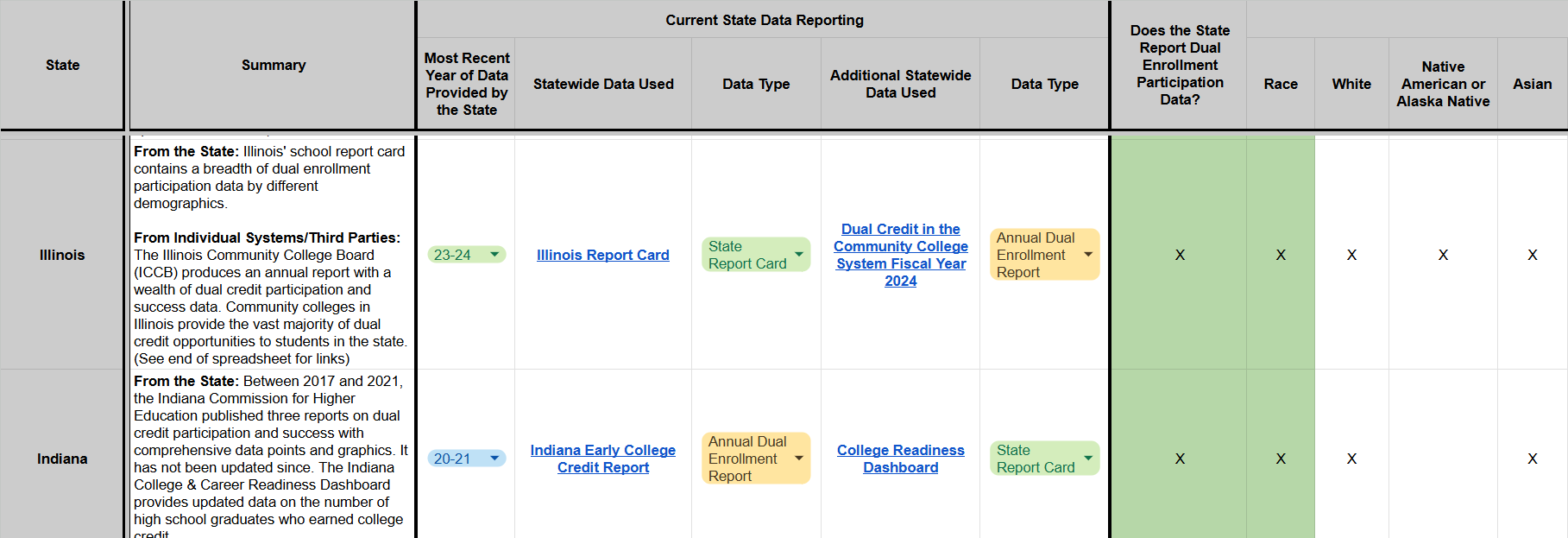Last Updated: August, 2025
Welcome to the College in High School Alliance's Dual Enrollment State Data Reporting Tracker.
This tracker is updated periodically with information on what dual enrollment data is publicly reported by all 50 states, including links to where the data can be accessed. The data elements we track are drawn from CHSA and the Data Quality Campaign's 2021 report, College in High School Programs & Data: Reporting and Using Dual Enrollment Data to Improve Equity.
We also include links to dual enrollment data reported by individual systems (for example, reports about enrollments just at community colleges or four year institutions) or third parties that have used statewide data to produce a report on dual enrollment participation and success. Data included in these individual system or third party reports is not included in the tracker, as the tracker is designed only for statewide dual enrollment data.
While this tracker notes all publicly reported dual enrollment data, we are aware that many states collect data on dual enrollment that they do not publicly report. If you are a researcher interested in understanding what data is accessible for education research, reach out to the state in question to understand the full data availability related to dual enrollment.
FREQUENTLY ASKED QUESTIONS
Who is this tracker for?
This tracker is designed for policymakers, advocates, intermediaries, and researchers to understand what data your state is reporting around dual enrollment, what data other states are reporting, and begin to think about how to advance dual enrollment reporting in the state to meet the state's goals for advancing dual enrollment.
This tracker is a starting place to ask questions (are we reporting the right dual enrollment data? Is there more we want to report? How do we encourage policymakers and practitioners to use this data to advance dual enrollment policy and practice?) and begin to assess your dual enrollment data reporting.
Are you expecting every state to report every column of dual enrollment data?
No. As discussed in College in High School Programs & Data (linked above), there are data reporting elements that CHSA believes should be foundational to every state's data reporting around dual enrollment. Those columns have been shaded in light green.
The additional data columns are designed to show other data elements that states report, and in some cases it is up to each state to decide how to specifically report certain types of data. For example, as it relates to student success, CHSA has listed the inclusion of student success data as foundational to dual enrollment data reporting, but it will be up to each state to decide what dual enrollment success data best meets its aims and is able to be collected and reported. In addition, for student participation, CHSA believes reporting gender, race, disability status, English learner status, and economic status are foundational, but which racial demographics a state might choose to report will be dependent on the state's demographic composition.
How do you define dual enrollment?
Dual enrollment programs are partnerships between high schools and institutions of higher education that allow high school aged students the opportunity to take a college course from the participating institution, for which if they pass the course they will receive college credit. States use different terms for these programs including dual credit, concurrent enrollment, and early college. This tracker collects information on what dual enrollment data is reported by the state regardless of modality or terms used.
Why do you only track public dual enrollment data when you admit many states have more data available?
Dual enrollment data must be publicly accessible so that it can be used by policymakers and practitioners to understand dual enrollment participation and success trends and develop solutions, whether at the policy or practice level, to address challenges. Dual enrollment data can tell us an important story about who is accessing dual enrollment, as well as how and where students are accessing dual enrollment, which is essential information to be able to develop the most robust dual enrollment partnerships possible. As a result, public reporting of dual enrollment participation and success data is essential for advancing the ecosystem forward, and should be prioritized by states.
How often will this tracker be updated?
We plan to update the tracker annually.
I have spotted an error or incomplete information. Who do I contact?
Reach out to Alex Perry, Coordinator of the College in High School Alliance, to request updates and corrections - alex.perry@flpadvisors.com
CONTRIBUTORS
Alex Perry, Foresight Law + Policy
Riley DeLacy, Foresight Law + Policy
Lidia Diaz-Fong, Foresight Law + Policy
Victoria Warkins, Foresight Law + Policy


